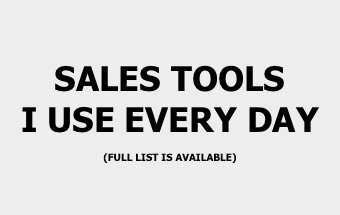If you are reading this, I know you use email. And the mere fact that you use email, means you need to write emails that sell.
Right now, even as I sit here typing at my desk, I am thinking – how can I write this blog post to sell you on the importance of “writing emails that sell”.
Even though I’m not writing an email, the thought process is the same. You’ll see why.
And here’s the good news. It’s not that complicated.
But it takes a little extra work on your part.
You see, I send out 10-20 emails per day. They are targeted emails to different leads.
Well you can imagine, since each email is targeted, it takes a little extra time on my end. Extra time thinking what to write. Extra time thinking how to write it.
So, it will take you extra time as well. Keep in mind, the more customization, the longer it takes.
And since your ultimate goal is to get the highest response rate. You have to weigh the tradeoff between time and volume.
I wish I could quickly calculate the optimal breakdown of my time between writing custom emails versus sending general email blasts. Where response rates are maximized.
But I simply have not looked into doing this yet. So in the meantime, let me know in the comments below, if you have figured this calculation out.
Anyways, let’s continue. Let’s get back to writing emails that sell.
Six specific strategies to write emails that sell
I use these six specific strategies on a daily basis. It’s a continuous thought process for me, every time I sit down to write emails. When you write your emails, walk through the steps yourself.
Know your email objective
Sounds simple, but this is overlooked all the time. How do I know?
Because I receive sales emails. And I still see emails that ramble on about product without any clear objective. Think about what you want to accomplish by writing the email. Maybe one of the following:
-
You want to schedule something
- a call, a demo, in person, conference call
-
You want to gather information
- fill out survey, status of deal, meeting participants
-
You want to drive traffic to website
- product announcement, recent news, signups, users
Whatever the objective, keep it in mind. Because it effects what you write in your subject, body, and ask.
Make your email address personal
I’m not suggesting you use your personal email address. I’m saying make the email address you send emails from, feel personal. For example, when you respond to leads, use your real name versus a generic department email.
-
Use your real name
- personal = Ian Adams, [email protected]
- generic = Sales, [email protected]
Secondly, think about the perception you want to create. Do you think a Vice President at Kraft Foods has an email like “[email protected] ”? Not likely.
-
Consider the perception of your email format
- small/startup = [email protected]
- big/enterprise = [email protected]
You could A/B test response rates based on this one. But I’d say just go with the image you want to portray. Small companies use first names. Big companies use full names. You decide.
Ok. Let’s move on to the meatier stuff.
Your subject line should tell not sell
This feels a little counter-intuitive at first. I know your goal is to sell. But for email subject lines, you need to tell.
There’s not a whole lot of debate here. MailChimp conducted a study on email subject lines. They analyzed the subject lines with the highest open rates versus the lowest open rates. Over 40 million emails sent, telling is always better than selling in email subjects.
That means, tell them what’s in the email. Don’t sell them what’s in the email. For example:
-
Telling subject lines (GOOD)
- eDiscovery and predictive coding
- Allstate discovery tools
- Call with Jill Hamilton
- Is predictive coding right for you?
-
Selling subject lines (BAD)
- Most Accurate Predictive Coding
- Game-changing litigation software
- Reduce your review costs by 80%
- Free eDiscovery Trial
When you make this slight change, you will notice the difference. What a simple change. And what a difference it makes.
Focus on the recipient in the email
Think about how many emails you get. I know my inbox is full. Now, think about your recipient’s. Their inbox could be even worse.
And for every email they see, they immediately ask themselves these five questions. It’s instantaneous. I’m talking milliseconds here.
The recipient asks these five questions immediately when they see your email:
- Who is this?
- How do I know you?
- What do you want from me?
- How do I benefit?
- …and what do I need to do?
Now, remember. Some of the answers to these questions may be implied. Meaning if your recipient recognizes your email address, than maybe they already know who you are and how they know you.
So then, you would only need to answer the other three questions. And the answers to those questions you must write in your email.
Always write a call to action at the end
This is crazy when people write emails with no call to action. You nearly negate all your effort of writing the email, if you don’t include a call to action at the end.
There are two ways you can write a call to action. Either when you ask a question or suggest an action. Take a look at these examples.
-
Ask a question
- Can we find a good time to chat next week?
- Is there a better number to reach you on?
- What are the other participants names and emails?
-
Suggest an action
- Let me know the best date and time that works for you.
- Get your copy of the whitepaper by clicking here.
- [continue reading here…]
Your call to action directly relates to your email objective. Know what you want and then ask for it.
Oh, and here’s the reason it must go at the end. Because it’s the last thing they will remember.
If you hide your call to action in the 2nd or 3rd sentence, sandwiched between two other sentences, your recipient will forget what you wanted.
And then there’s a good chance they won’t make the effort to find out again.
Write a call to action at the end of your email.
Keep your signature simple
You may not think your signature is a big deal. Let me tell you, it is.
No one wants to read your, fax number, pinterest profile, “consider the environment” notification, and confidential disclaimer.
Keep your signature simple. Only include the most pertinent information. In fact, stick to the following info, in order of importance:
- Your name
- Your title (in some cases, do not use)
- Your phone number
- Your email address
- You website
- Your social media profile
Ultimately, it’s about understanding your recipient. Understanding what channels they communicate on. Maybe a fax number is critical in your line of work.
Most likely not, but if it is, then include it. Certain industries have certain preferences. Know yours.
Conclusion
All this brilliant content is actually from a presentation I gave last week.
Oh by the way, why didn’t you make it?! Oh, what? You were busy.
Yea right. Well, I published the presentation for everyone anyway.
It includes real sales email examples. Both good and bad. So you can tell the difference. But you’ll have to download the pdf of the presentation here to see the email examples. Or here:
That’s all for now. Did I miss anything on how to write emails that sell?





6 Comments How to Write Emails that Sell